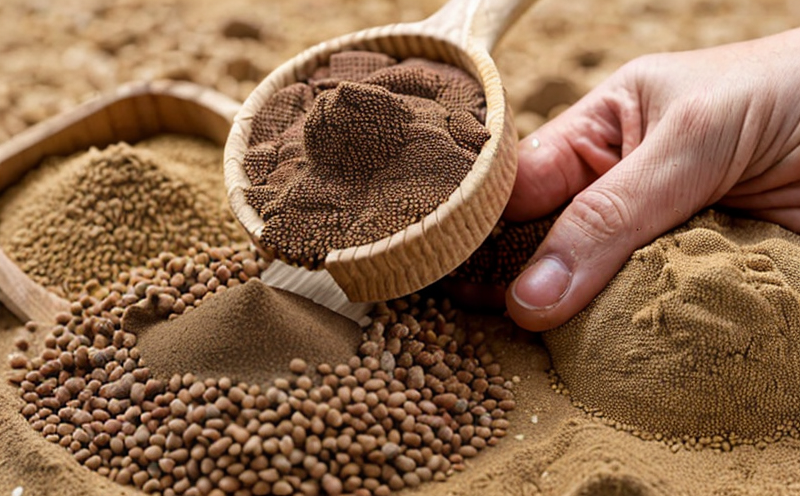Crude Fiber Content Testing in Feed
The crude fiber content testing in feed is a critical component of ensuring animal health and welfare. Crude fiber, often referred to as dietary fiber, plays an essential role in the digestive process by promoting gut health and providing a source of energy for animals. However, excessive or insufficient amounts can lead to significant issues such as weight gain, malnutrition, or even gastrointestinal disorders.
Crude fiber content testing involves determining the proportion of indigestible plant materials in feed samples. This test is crucial for quality control purposes, ensuring that feed meets specific nutritional requirements and regulatory standards. The methodology typically adheres to internationally recognized standards such as ISO 6860:2013 or AOAC International’s Official Method 975.42.
Sample preparation is a meticulous process involving several steps to ensure accuracy. Samples are first weighed accurately, then dried in an oven at a specific temperature (e.g., 105°C) until constant weight is achieved. After drying, the samples undergo ashing by incineration at 550°C for approximately two hours. The resulting residue is sieved through different mesh sizes to separate the crude fiber from other components like starch and proteins.
Instrumentation used in this testing includes analytical balances capable of measuring precision down to milligrams, muffle furnaces for ashing, and sieves with varying aperture sizes. Modern laboratories often employ automated systems that streamline sample preparation and reduce human error. Reporting standards require detailed documentation including test parameters, specimen pre-treatment steps, and final results expressed as a percentage by weight.
Understanding the implications of crude fiber content is vital for various stakeholders within the agricultural sector. For instance, feed manufacturers must ensure their products comply with nutritional guidelines set forth by regulatory bodies like FDA (United States) or EMA (European Medicines Agency). Farmers also benefit from precise knowledge about the fiber content since it influences feeding behavior and overall productivity.
Excessive crude fiber can cause problems such as reduced palatability, leading to decreased consumption levels among livestock. On the contrary, insufficient amounts may result in poor rumen function or suboptimal performance metrics. Therefore, accurate measurement is paramount for maintaining optimal nutritional balance.
Why It Matters
The importance of accurate crude fiber content testing cannot be overstated, especially given its direct influence on animal health and productivity. Inadequate levels can lead to digestive disorders while overabundance might cause reduced feed intake due to lower palatability.
- Improved Nutritional Balance: Ensures that all essential nutrients are present in correct proportions, supporting optimal growth rates and reproductive success.
- Promotes Digestive Health: Adequate fiber content aids in maintaining a healthy gut microbiome which is crucial for efficient nutrient absorption.
For quality managers, compliance officers, R&D engineers, and procurement teams involved in animal feed production or supply chain management, understanding these nuances is paramount. It allows them to make informed decisions regarding ingredient sourcing, formulation adjustments, and process improvements aimed at enhancing product quality and safety.
Industry Applications
Crude fiber content testing finds application across multiple segments within the agricultural industry including dairy farming, poultry production, swine husbandry, and companion animal care. Each sector has unique requirements concerning crude fiber levels tailored to meet specific dietary needs.
- Dairy Industry: High fiber diets are used during early lactation periods to stimulate rumination and improve milk yield.
- Poultry Production: Fiber content influences feed consumption patterns and litter quality, impacting both environmental sustainability and bird performance.
- Swine Husbandry: Controlled amounts of fiber promote efficient digestion and waste management practices.
In each case, precise measurement helps tailor feeds to meet individual animal requirements, thereby maximizing economic returns for producers while promoting sustainable farming practices.
Customer Impact and Satisfaction
Accurate crude fiber content testing directly impacts customer satisfaction by delivering consistent products that consistently meet expected standards. This builds trust between suppliers and customers, fostering long-term relationships based on reliability and quality assurance.
- Enhanced Reputation: Reliable test results contribute to a positive reputation among clients who appreciate transparency and adherence to best practices.
- Increased Sales: Satisfied customers are more likely to recommend services or products, thus expanding market reach.
Moreover, compliance with stringent regulations enhances the credibility of suppliers in competitive markets. This aligns perfectly with global trends towards organic and ethically produced goods where transparency is key.





